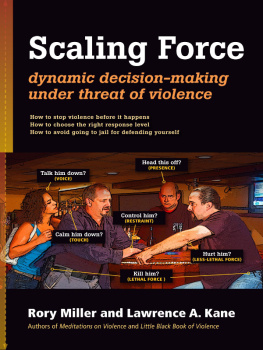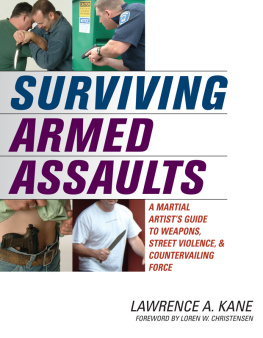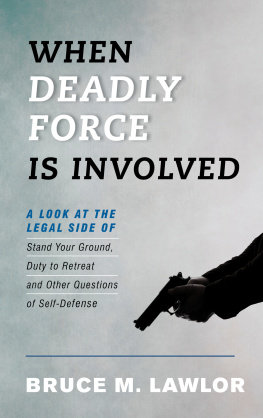
Praise for Scaling Force
I love this book! I like the authors as people and I highly recommend all their work. However, I have to say that I think this book is my favourite. Its my favourite because it superbly addresses what I feel is the biggest problem in modern self-defence training; namely that far too many people think that self-protection is the same as martial arts, is the same as fighting. Dont get me wrong, I love the martial arts and I enjoy a good spar in the dojo, but its a big mistake to think that they give you all you need to protect yourself from violence.
Whenever I tell people that they should be careful not to confuse martial arts and fighting for self-protection, the common reaction is for them to get all bent out of shape and tell me how effective their style of fighting is. What they fail to grasp is that you could be studying an amazingly effective system of fighting, but self-protection is not about fighting. I know some great fighters who are piss-poor when it comes to defending themselves. They end up in fights all the time, some have ended up in jail, and three are missing body parts (two ears, one finger, and a testicle overall). Are they effective fighters? Sure! Were their self-protection skills effective? Nope!
Put it this way, would you learn road safety from the guy who said, Ive been ran over by one thousand cars and I survived every one! This is what we see all the time in self-protection training though: the equivalent of people teaching how to roll over car bonnets (that should be hoods in the US right?) and passing that off as all you need to know about road safety. Sure, self-protection has a physical component, but its a massive mistake to take that one part and believe it to be the whole. Even the physical side of self-protection is not the same as a fight, but lets park that for now.
If you are serious about learning self-protection, and not indulging some testosterone fuelled, celluloid inspired fantasy, then you need a much wider skill set than most appreciate.
You need to know the law, and in my experience here in the UK most instructors misunderstand the law to the point where they terrify their students into inaction or make them jailbirds in waiting.
You need to know how physical conflict can be avoided, and in my experience most simply say avoid fights if you canand having said that lets get back to how to rip windpipes out. There are skills associated with avoiding violence and, in my view, they are far more important to acquire than a powerful right cross: lip service is not enough. Its a pet peeve of mine when I see self-defence books and courses begin with Lesson 1: How to get out of a headlock. They should back up a bit and look at the whole chain of events that lead to them being in the headlock. If you dont have the skills to stop situations before they develop into physical violence guess what youre going to experience a lot of? Self-protection is about keeping ourselves safe, right?
You need to be able to use the right tools for the circumstances. There is an old saying, When all you have is a hammer, then every problem is a nail. If fighting is all you have, then thats going to be your solution to everything, whether it is applicable or not. Is that punch to the throat really what you need to deal with a drunk relative at wedding? (Im assuming drunken family brawls happen as commonly at US weddings as they do at UK ones.) Are you really going to try to reason with a person who is being unreasonable? I once witnessed a training course where the instructor advised trying to calm a person down when they were already throwing punches. Not a good idea! You need to be able to use the tools and skills most applicable to the circumstances; and you cant do that if you cant read the circumstances or you dont have those tools. This book can help fix that.
As I read the book what struck me was how similar this was to how the UK police force are trained. And the reason they are trained to cover all of the topics herein is because thats what they need to effectively address conflict and violence as it really is. Many martial artists and self-defence instructors work backward and reinvent violence to fit their pre-existing solution. However, the only way to be effectively prepared is to look at the reality of the situation and forge a solution from there. Anyone and any group who does that will find their answers will be as presented herein.
I feel this has to be the most thorough presentation of true self-protection out there. The knowledge contained within is what anybody who is serious about keeping himself safe needs to know. I hope the book is as massively successful as it deserves to be and that in doing so it busts once and for all the myth that martial arts and fighting are one and the same as self-protection.
Iain Abernethy, 6th Dan, British Combat Association Hall of Fame Member (www.iainabernethy.com)

When it comes to using your self-defense training you only have two problems. One is if it doesnt work. Two is if it does work. Both can get you into serious trouble. This book is for keeping you out of the second kind of trouble. A raw and horrible truth is most of what you think you know about self-defense is advertising, if not an outright lie. The biggest myth is that self-defense is a martial art, MMA or combatives term. Its not. It is a legal term. It is those standards you will be held accountable to. Youll not be judged according to what you were told in training nor what you heard on an internet forum filled with cyber-warriors, well I would have studs and there-are-no-rules-in-a-street-fight commandos. Your actions will be judged by legal standards. Both Miller and Kane have hundreds of hands-on violent encounters under their belts. They understand the importance of knowing the legal restrictions of force, how to judge the danger, how to choose the right response level, how to articulate those choices, and how to navigate the trap-filled aftermath of violence. Information they share with you in this book will keep you from going to prison for defending yourself.
Marc MacYoung (www.nononsenseselfdefense.com)

There are two aspects of self-defense training that are sorely lacking, in my experience. But first, let me ask you a question: if I told you I was opening a driving school, but the only aspects of driving I would concentrate on would be proper turning of the steering wheel, shifting gears, pedal control, seatbelts, use of mirrors and the like, while disregarding things like what side of the road to drive on, the speed limit, right of way, and the other legalities that make driving from Point A to Point B possible, would you think I was crazy? Yet this happens every day in martial arts training across the worldstudents being taught every aspect of the mechanics of their art, all the moves, katas, forms, etc., yet not being taught that things like laws can limit or allow certain actions. If you win the fight but end up in prison, did you really win? No one would learn to drive a car from someone who doesnt teach traffic laws, but instructors do it all the time in the martial arts. So think of this book as an excellent general introduction to figuring out what side of the road you can drive on. It will be an eye-opener.
Secondly, imagine that not only did you not learn about traffic laws, but the very first time you drove was having to drive a family member to the emergency room at rush hour, in an ice storm. Thats a steep learning curve, and make no mistake: Thats also what a critical incident can feel like, when all of your martial training, learned in the comfort and safety of the
Next page












